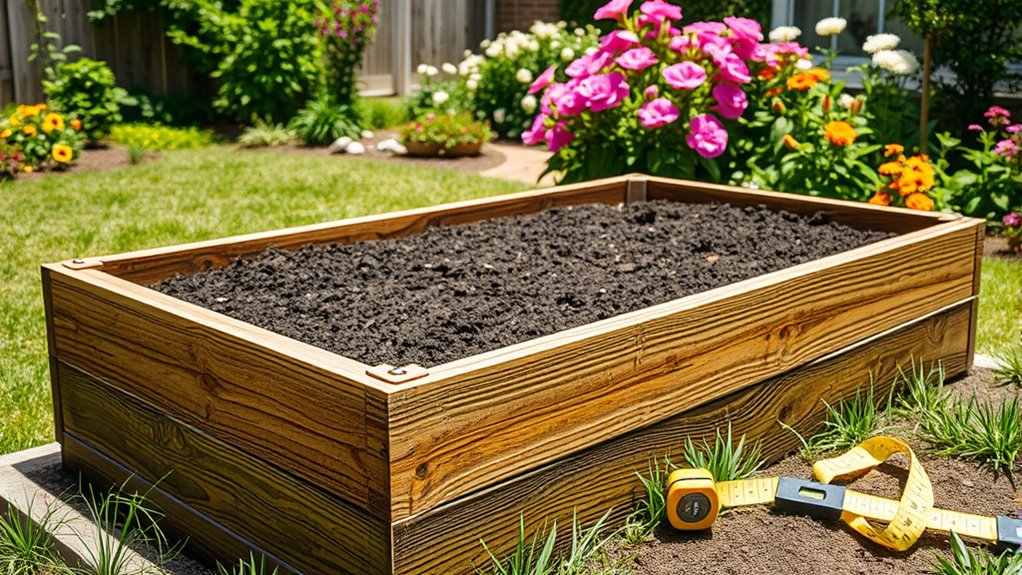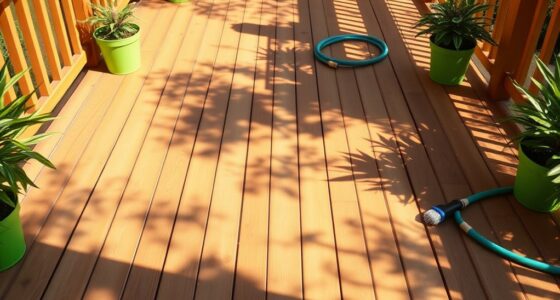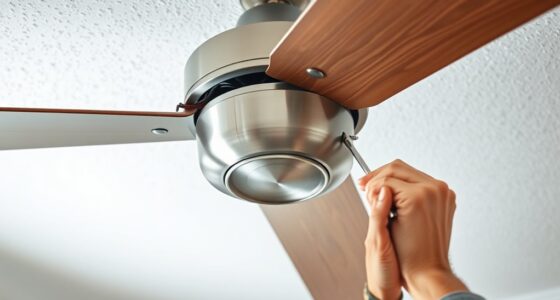To build a raised garden bed, start by choosing a sunny, well-draining spot with good airflow. Measure and mark the area accurately, then build a sturdy frame using durable materials like cedar or composite lumber, securing corners with quality fasteners. Clear weeds and level the ground before filling the bed with compost-enriched soil and organic amendments. After planting, mulch and maintain your garden to guarantee healthy growth—learn more steps to create a thriving space.
Key Takeaways
- Select a site with good drainage, ample sunlight, and protection from wind, ensuring proper soil and water access.
- Measure and mark the area accurately, then construct a sturdy frame using durable, weather-resistant materials like cedar or composite lumber.
- Prepare the soil by removing weeds and debris, testing pH levels, and amending with compost and soil conditioners for optimal fertility.
- Fill the bed with layered soil amendments, including compost and organic matter, to enhance drainage and nutrient content.
- Plant your vegetables, herbs, or flowers, then mulch and maintain regularly by watering, weeding, and rotating crops seasonally.
Planning Your Garden Bed Design
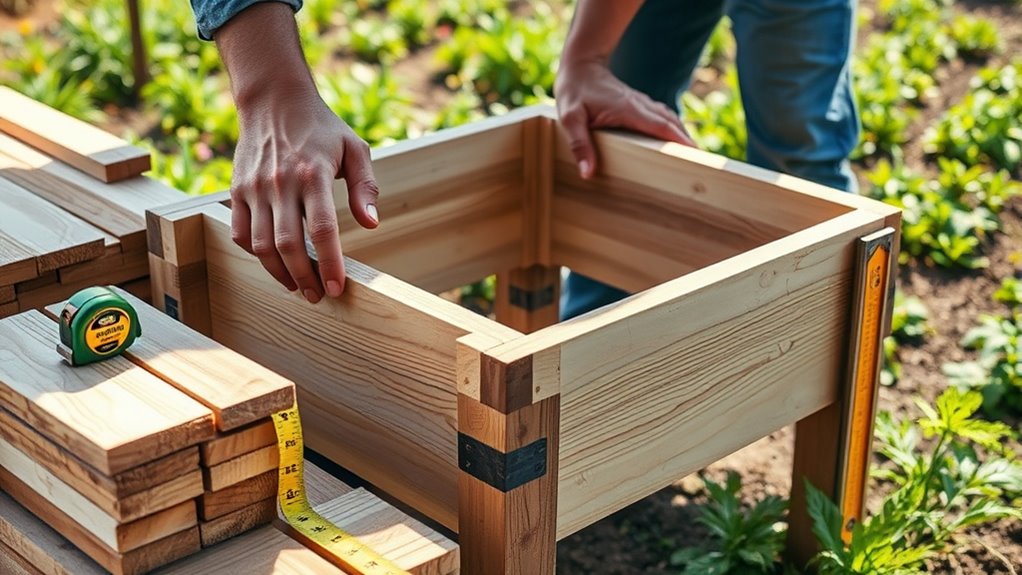
Before building your raised garden bed, it is essential to plan its design carefully. You need to consider soil drainage to prevent water from pooling and causing root rot. A well-draining soil mix ensures your plants get enough moisture without becoming waterlogged. Additionally, sunlight exposure plays a key role in plant growth. Position your bed where it will receive ample sunlight throughout the day, ideally six to eight hours for most vegetables and flowers. Think about how the sun moves across your yard and avoid shaded areas caused by trees or structures. Proper planning of drainage and sunlight exposure helps create an ideal environment for your plants to thrive, making your raised garden bed more productive and easier to maintain.
Choosing the Right Location
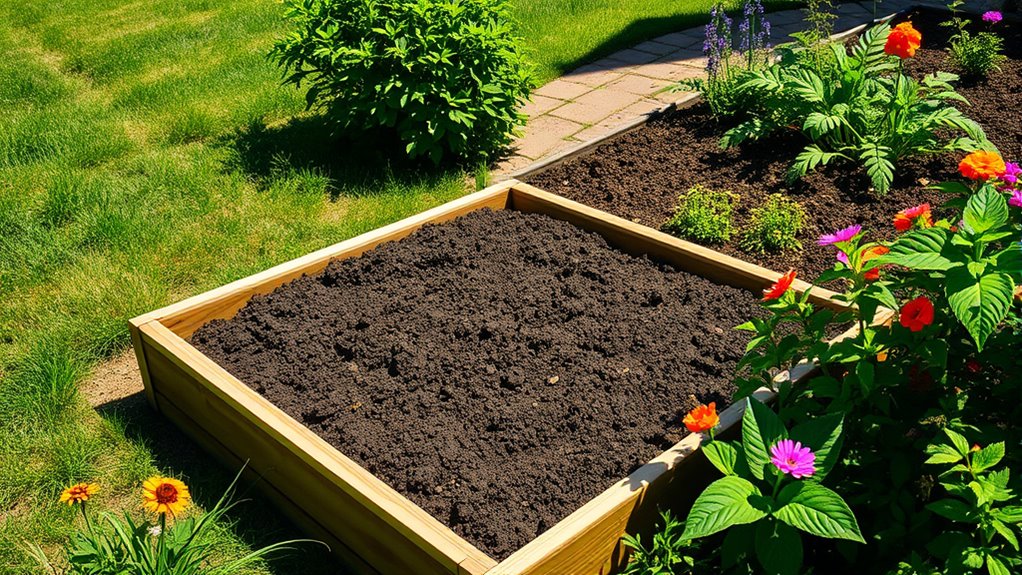
Selecting the right location for your raised garden bed is essential because it directly impacts plant health and growth. You need a spot with ample sunlight exposure—most vegetables thrive with at least 6 hours of direct sun daily. Also, avoid areas shaded by nearby structures like fences or trees, which can limit sunlight. Consider wind protection and drainage to prevent waterlogging. Use the table below to evaluate potential sites:
| Factors | Ideal Conditions |
|---|---|
| Sunlight Exposure | Minimum 6 hours of direct sunlight daily |
| Nearby Structures | No shading or obstruction from buildings or trees |
| Drainage & Wind | Well-drained area, protected from strong winds |
Additionally, understanding your local climate can help determine the best spot for your garden, ensuring plants are resilient to weather variations. Incorporating soil quality considerations during site selection can also improve plant growth and health. Choosing a site with consistent water access will support regular irrigation and healthy development. Ensuring your site has access to water sources is essential for regular irrigation and maintaining healthy plants. Enhancing your garden layout with proper site selection can lead to healthier plants and better yields.
Selecting Materials for Your Bed
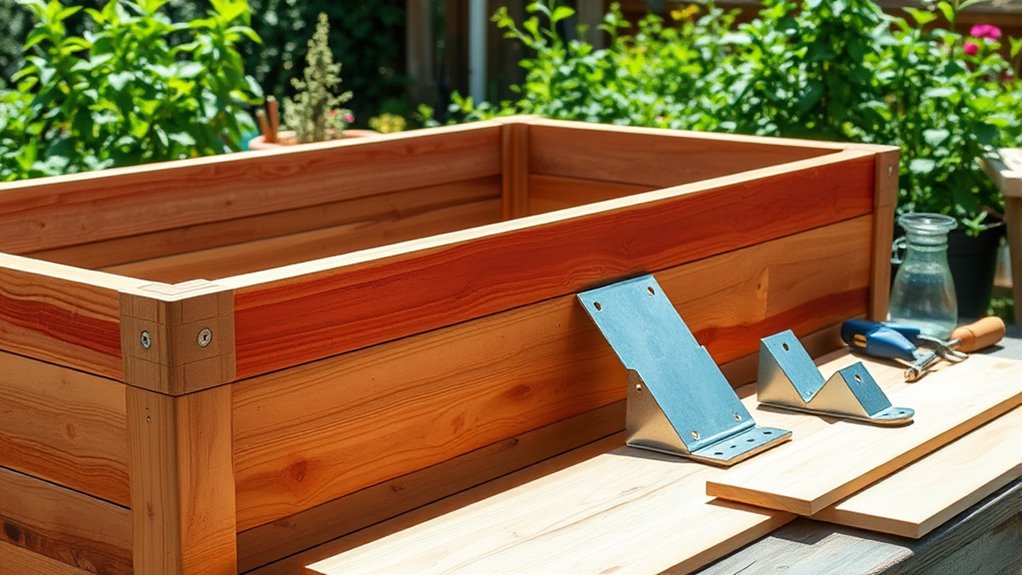
Choosing the right materials is essential for your garden bed’s durability and cost. You’ll want to contemplate options that last over time without breaking the bank or being hard to find. Let’s explore how durability and availability influence your choices. When selecting materials, consider the soil health benefits of organic options, which can contribute to healthier plant growth and long-term sustainability. Using resale value considerations can also guide you toward materials that maintain their appearance and function over the years, reducing the need for replacements. Additionally, selecting materials with high contrast ratio can help you assess the impact of different textures and finishes on visual appeal in your garden design. Opting for materials with easy maintenance features can further extend the lifespan of your raised bed and reduce ongoing upkeep efforts.
Material Durability and Longevity
When it comes to building a durable raised garden bed, the materials you choose play a crucial role in ensuring it lasts through seasons of gardening. You want materials with strong material resistance that can withstand moisture, pests, and soil contact over time. Look for options with weatherproof properties, such as cedar, composite lumber, or treated wood designed for outdoor use. These materials resist rot, decay, and insect damage better than untreated alternatives. Choosing durable materials means your bed will maintain its structure and appearance longer, reducing the need for repairs or replacements. Keep in mind that investing in weather-resistant options now saves you time and money in the long run, helping your garden thrive season after season. Incorporating eco-friendly materials can also contribute to sustainable gardening practices and environmental health.
Cost and Availability
The cost and availability of materials considerably impact your options for building a raised garden bed. Your choice depends on your budget and what’s accessible locally. Here are some budget gardening tips to keep costs low:
- Use recycled or reclaimed wood, which is often cheaper and eco-friendly.
- Check local hardware stores or online marketplaces for affordable garden bed accessories.
- Consider composite or plastic options if wood prices are high, but compare durability and cost.
- Incorporating sustainable materials can maximize your budget while ensuring your garden bed remains durable. Additionally, exploring low-cost building options can help you create a sturdy and functional garden bed without overspending.
Measuring and Marking the Area
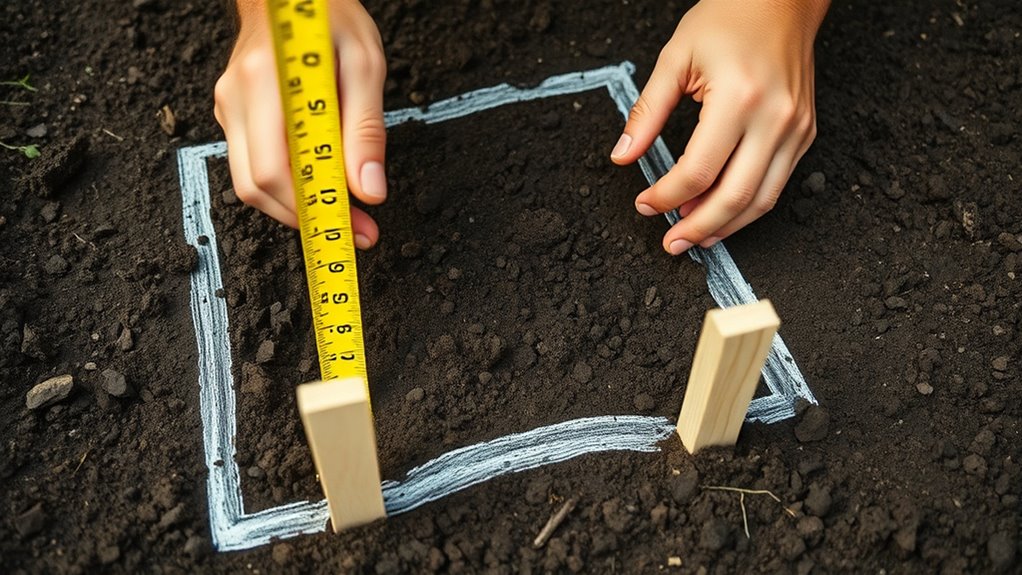
First, choose a spot that gets plenty of sunlight and has good drainage. Then, use a tape measure and stakes to mark out the exact boundaries of your bed. Make sure your markings are straight and precise before proceeding to build. Incorporating vertical storage solutions during planning can help maximize space and organization in your garden area. Additionally, assessing soil quality beforehand ensures your plants will have the best growing conditions. Regularly monitoring projector bulb maintenance can prevent unexpected issues and prolong the lifespan of your equipment. When planning your garden, consider the cost and budgeting aspects to ensure your project stays within your financial means.
Choosing the Right Spot
Choosing the right spot for your raised garden bed is essential for its success. You want a location with proper sunlight exposure, ideally 6-8 hours daily, to ensure healthy plant growth. Also, check soil moisture levels; the spot shouldn’t be prone to standing water or dryness. Here are some tips:
- Pick a sunny area that isn’t shaded by trees or buildings.
- Ensure proper drainage to prevent waterlogging.
- Measure the space to fit your bed size comfortably, leaving room for easy access and maintenance.
- Consider the 1023 Jack when selecting a location to ensure your plants thrive in favorable conditions.
- Understanding glycolic acid benefits can help you select optimal conditions for plant health and soil quality.
Marking Accurate Boundaries
Once you’ve selected the ideal spot, it’s essential to accurately mark the boundaries of your raised garden bed to ensure proper placement and size. Use stakes and string to outline the shape, keeping in mind the garden bed aesthetics you desire. Consider wildlife considerations, like avoiding areas near wildlife pathways or plants that attract animals. To make this process clearer, review the table below:
| Step | Tip |
|---|---|
| Measure dimensions | Use a tape measure for precise length and width |
| Mark corners | Drive stakes into each corner for clarity |
| Check boundaries | Double-check measurements before finalizing |
This approach helps you create clean, accurate borders that fit well into your landscape while respecting local wildlife.
Building the Frame
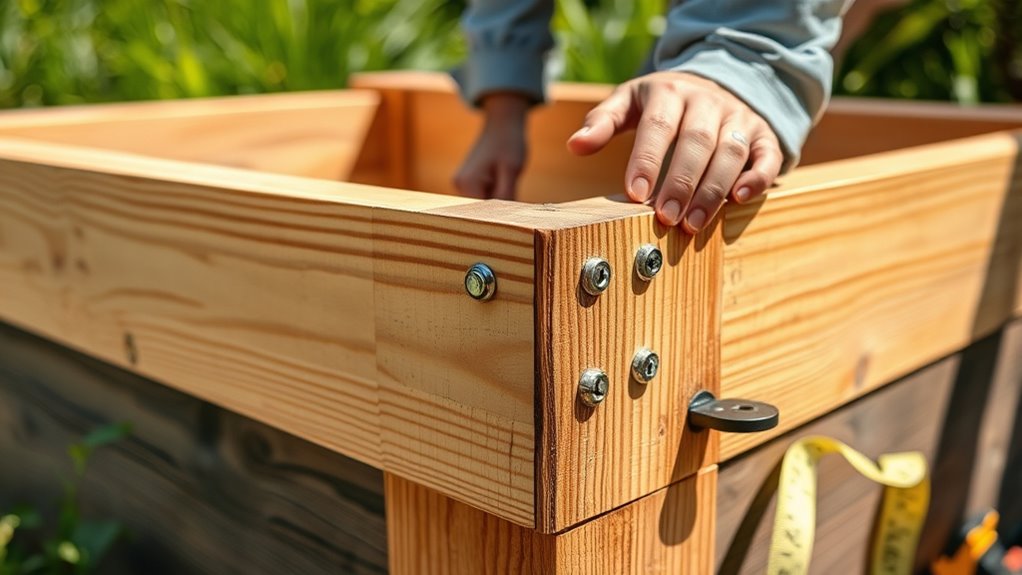
To build a sturdy and durable frame for your raised garden bed, start by selecting quality lumber, such as cedar or composite, that can withstand outdoor conditions. Next, focus on creating strong corner joints, using techniques like overlapping boards or metal brackets to guarantee stability. Reinforcement techniques are essential—consider adding metal corner braces or exterior-grade screws to prevent shifting over time. When assembling, ensure that you use appropriate fasteners for outdoor durability. Secure each corner joint tightly with appropriate fasteners. Use reinforcement techniques like brackets or additional screws for added strength. Double-check that all sides are level and square before tightening completely. Additionally, choosing a name that reflects the breed’s personality can help personalize your garden project. These steps ensure your frame remains solid and weather-resistant, providing a reliable foundation for your garden. Properly built corners and reinforcements help your raised bed stand the test of time, especially in areas prone to noise pollution that can affect outdoor spaces.
Preparing the Bed Area
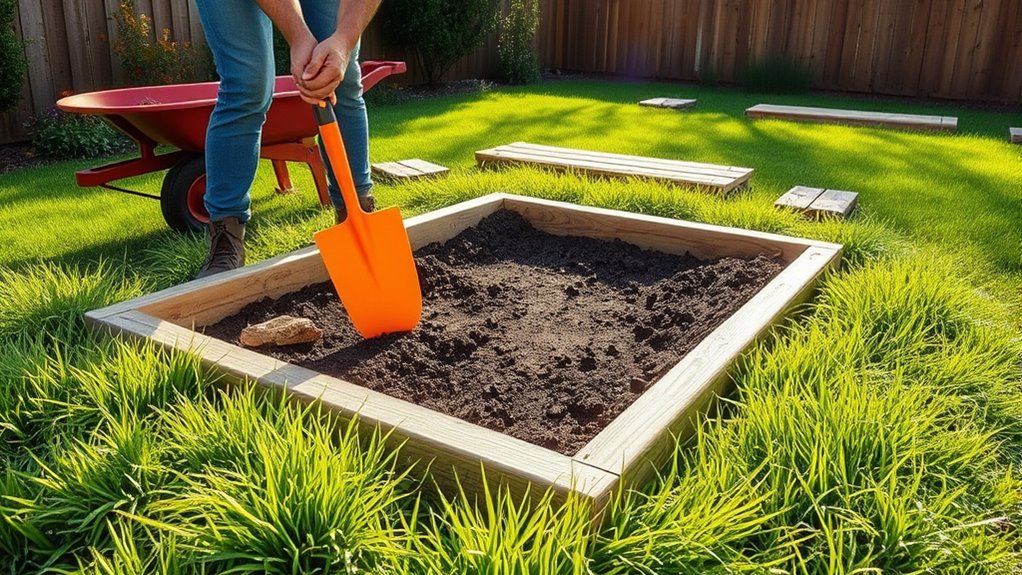
Before installing your raised garden bed, you need to prepare the bed area thoroughly. Start with soil testing to determine its pH and nutrient levels, guaranteeing your plants will thrive. If the soil is too acidic or alkaline, amend it accordingly. Next, clear the area of weeds, debris, and roots that could compete with your garden plants. Pest prevention is also essential; inspect the area for signs of pests or tunnels, and consider installing barriers or traps if needed. Improving drainage by leveling the ground helps prevent waterlogging, which can damage roots. Taking these steps guarantees your raised bed has a healthy foundation, reduces pests, and promotes ideal plant growth from the start. Proper preparation saves you time and effort later on.
Filling the Bed With Soil and Compost
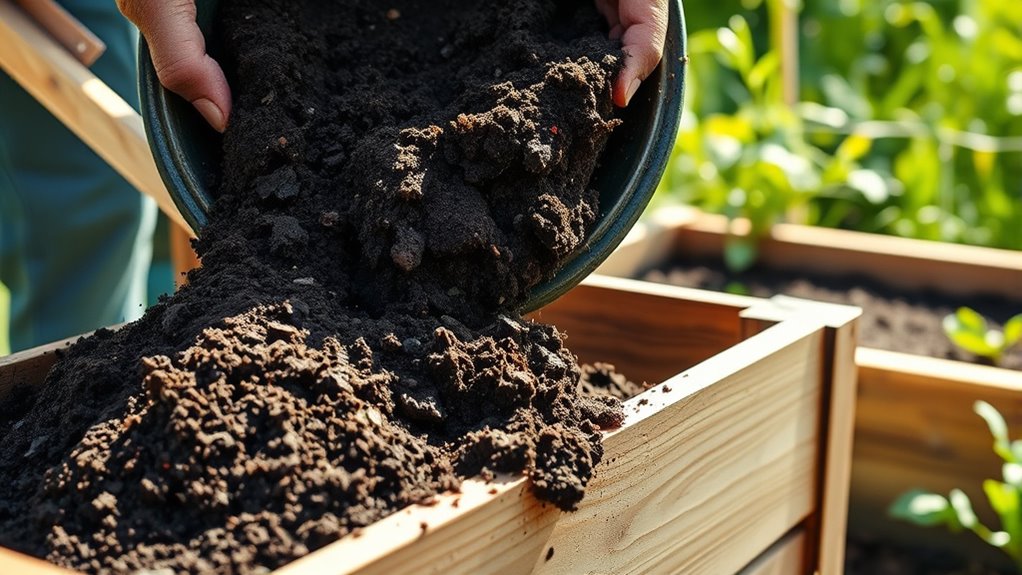
Filling your raised garden bed with the right mixture of soil and compost is essential for healthy plant growth. Start by adding a base layer of soil amendments to improve drainage and nutrient content. Then, incorporate compost layering to boost organic matter and microbial activity. To do this effectively:
- Mix soil amendments like composted manure or peat moss into the existing soil.
- Create layers of compost on top of the amended soil, about 2-3 inches deep.
- Repeat layering until the bed is filled, ensuring even distribution.
- Incorporate soil testing to determine specific nutrient needs and optimize your soil mixture.
This approach promotes nutrient availability and aeration, giving your plants a strong foundation. Proper soil and compost layering also help retain moisture and prevent compaction, making your garden bed a thriving environment for all your plants.
Planting and Maintaining Your Garden

Once your raised garden bed is filled with nutrient-rich soil and compost, you can begin planting your chosen vegetables, herbs, or flowers. Use proper watering techniques to keep the soil consistently moist but not waterlogged, watering early in the morning or late in the afternoon. Mulching helps retain moisture and suppress weeds. Regularly inspect your plants for pests and take proactive pest control measures, such as removing insects by hand or using organic repellents. Rotate crops each season to prevent soil depletion and reduce pest buildup. Keep an eye on plant health, removing diseased or damaged foliage promptly. With attentive watering and pest control, your garden will thrive, rewarding you with healthy, vibrant plants throughout the growing season.
Frequently Asked Questions
How Deep Should My Raised Garden Bed Be for Different Plants?
You should consider different depths based on your plants’ needs. For vegetables, aim for a depth of at least 12 inches to allow proper soil preparation and root growth. Herbs and shallow-rooted plants might do well in beds 6 to 8 inches deep. Always customize your bed dimensions to suit specific plants, ensuring they have enough space to thrive. Adjust depth accordingly for bigger plants or root vegetables.
What Are the Best Pest Control Methods for Raised Beds?
Think of pest control in your raised bed as a shield for your garden’s health. You can use companion planting, like marigolds next to tomatoes, to naturally deter pests. Natural repellents such as neem oil or garlic spray also work effectively. I once tried planting basil near my peppers, and it kept bugs away, proving that smart choices create a pest-free haven without harsh chemicals.
Can I Build a Raised Bed on Uneven or Sloped Ground?
Yes, you can build a raised bed on uneven or sloped ground. To do so, start with proper soil preparation by leveling the base or creating tiered sections to prevent shifting. Adjust the bed height to match the slope, ensuring stability and proper drainage. Using sturdy materials and securing the structure helps maintain the bed’s shape. This approach allows you to create a productive garden regardless of your yard’s terrain.
How Often Should I Water My Raised Garden Bed?
Think of your garden as a delicate dance, where watering is the rhythm guiding healthy growth. You should water your raised bed when the top inch of soil feels dry, usually every 1-3 days. Adjust your watering schedule based on weather and plant hydration needs, ensuring you don’t overwater or underwater. Consistent, deep watering encourages strong roots and vibrant plants, keeping your garden lively and thriving.
What Are Eco-Friendly or Sustainable Materials for Garden Beds?
You want eco-friendly options for garden beds, so consider using natural wood, which is biodegradable and renewable. Recyclable plastics are also a sustainable choice since they repurpose waste materials and last long. By choosing these materials, you help reduce environmental impact. Natural wood offers a classic look and biodegrades naturally, while recyclable plastics provide durability with a lower ecological footprint, making your garden both sustainable and functional.
Conclusion
Building a raised garden bed is a rewarding project that transforms your outdoor space. Don’t worry if it seems overwhelming at first—just follow these steps, and you’ll create a beautiful, productive garden. Remember, investing in quality materials and proper planning guarantees your bed lasts for years. With patience and care, you’ll enjoy fresh veggies and vibrant flowers, proving that a little effort now pays off in a thriving garden you can be proud of.

